Concawe Review
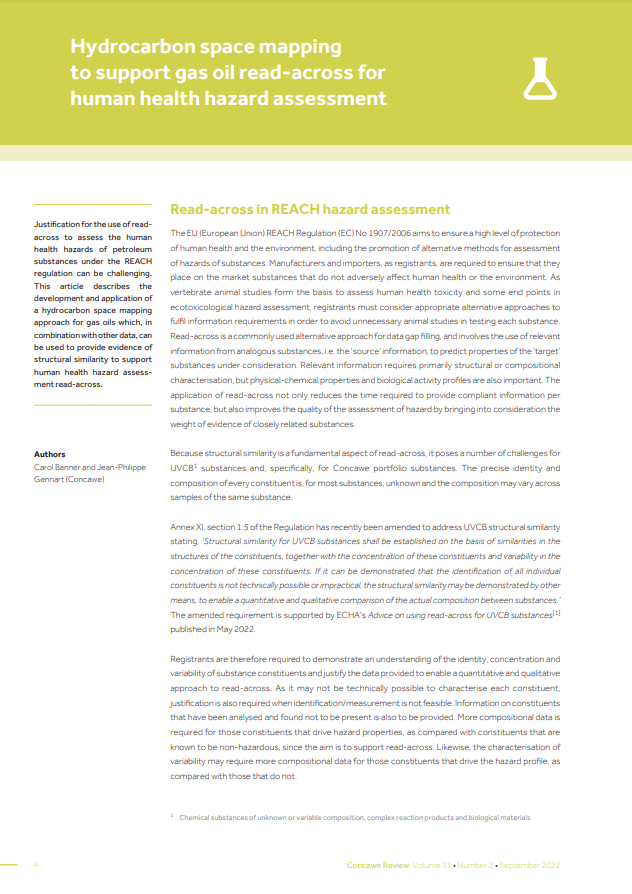
Concawe Reviews
Hydrocarbon space mapping to support gas oil read-across for human health hazard assessment
As vertebrate animal studies form the basis for assessing certain human health and ecotoxicity hazards under the EU (European Union) REACH regulation, appropriate alternative approaches to fulfil info...
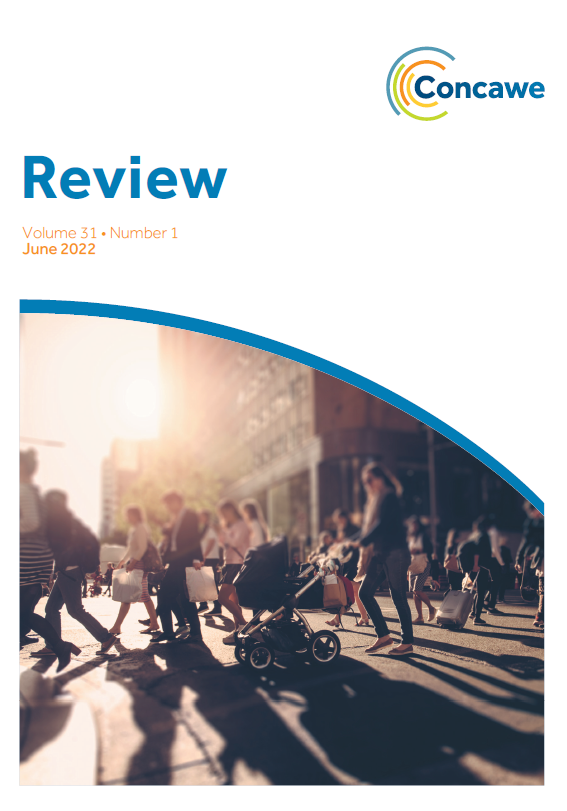
Concawe Reviews
Concawe Review 31.1
Evaluation of pathways to decarbonise transport, simulations of the impact of our products on air quality, evaluation of the safety of our industrial and supply activities: the articles in this editi...
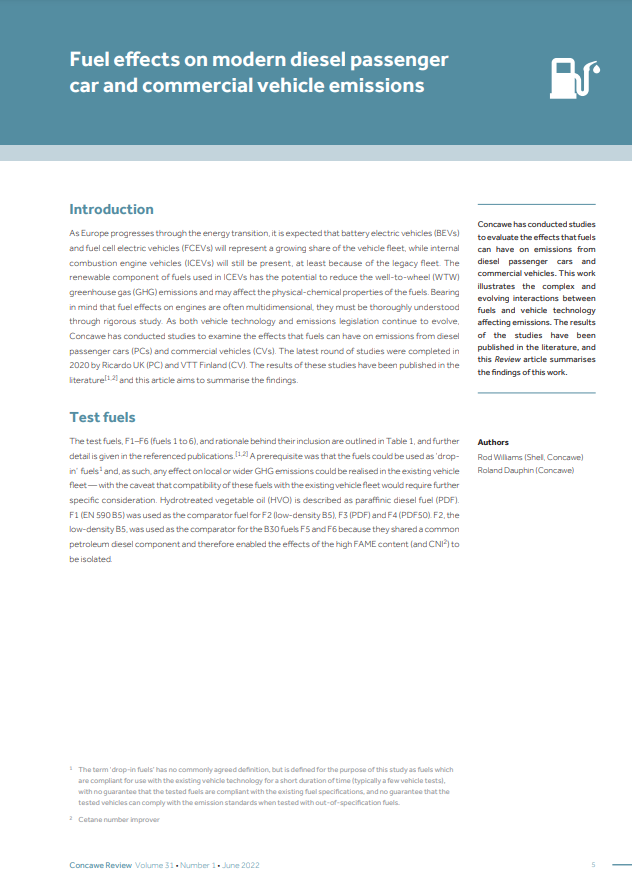
Concawe Reviews
Fuel effects on modern diesel passenger car and commercial vehicle emissions (Concawe Review 31.1)
As both vehicle technology and emissions legislation continue to evolve, Concawe has conducted studies to examine the multidimensional effects that fuels can have on greenhouse gases (GHGs) and pollut...
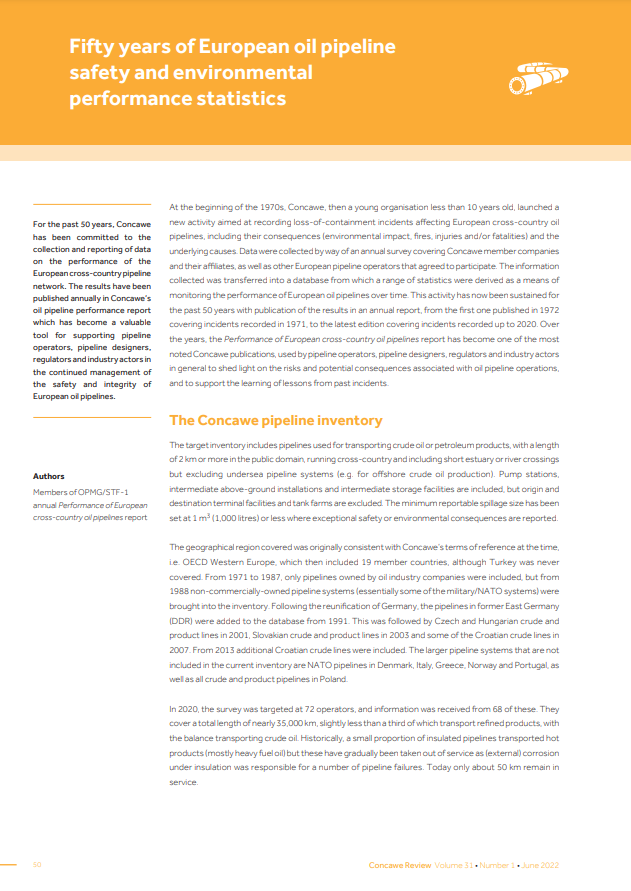
Concawe Reviews
Fifty years of European oil pipeline safety and environmental performance statistics (Concawe Review 31.1)
At the beginning of the 1970s, Concawe, then a young organisation less than ten years old, launched a new activity aimed at recording loss-of-containment incidents affecting European cross-country oil...
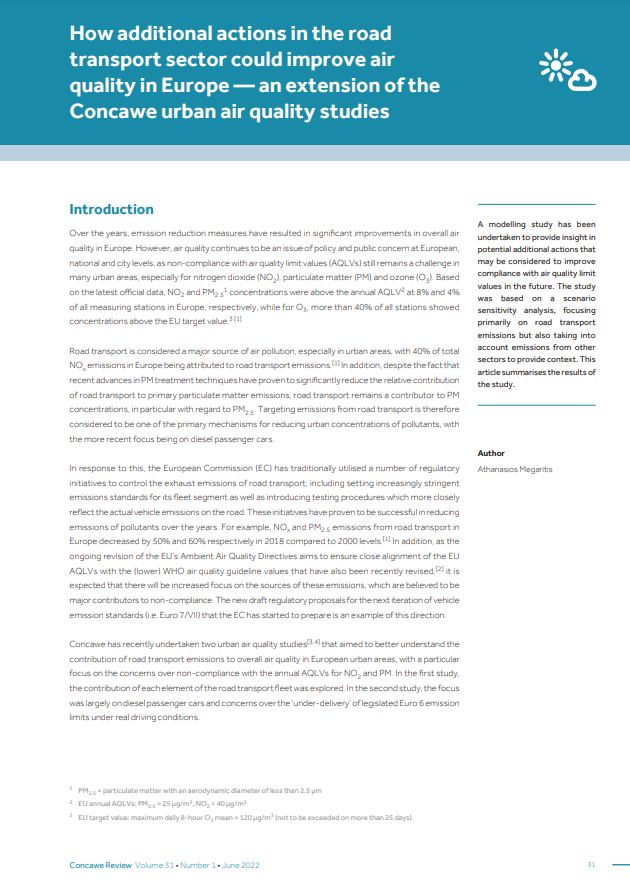
Concawe Reviews
How additional actions in the road transport sector could improve air quality in Europe — an extension of the Concawe urban air quality studies (Concawe Review 31.1)
This article presents results from a modelling study carried out to examine how concentrations of the major urban pollutants (i.e. nitrogen dioxide (NO2), particulate matter (PM) and ozone (O₃)) wou...
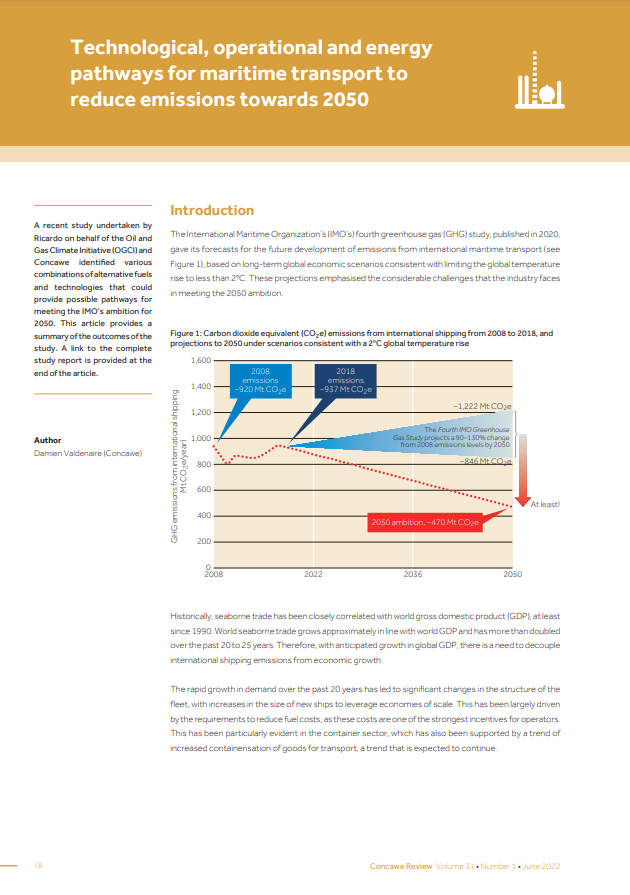
Concawe Reviews
Technological, operational and energy pathways for maritime transport to reduce emissions towards 2050 (Concawe Review 31.1)
This article provides a summary of a ‘deep dive’ study into the future development of emissions from international maritime transport. The study is part of Concawe’s Low Carbon Pathways project,...
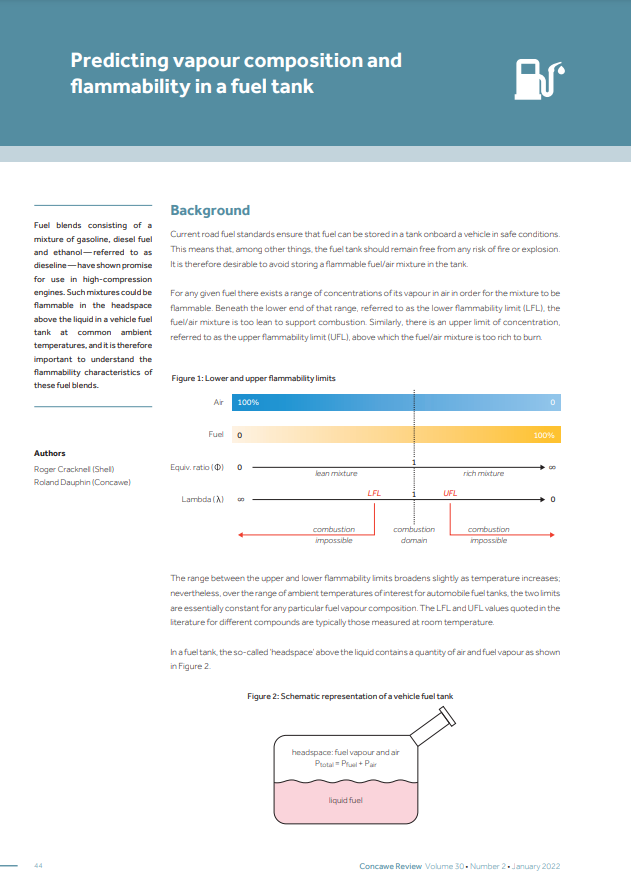
Concawe Reviews
Predicting vapour composition and flammability in a fuel tank (Concawe Report 30.2)
Fuel blends consisting of a mixture of gasoline, diesel fuel and ethanol—referred to as dieseline—have shown promise for use in high-compression engines. Such mixtures could be flammable in the he...
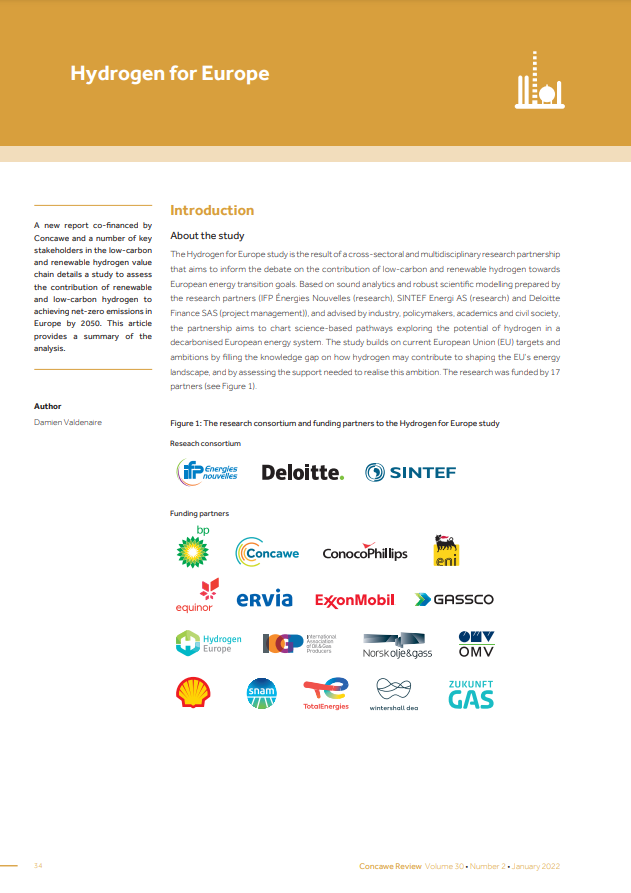
Concawe Reviews
Hydrogen for Europe (Concawe Review 30.2)
A new report co-financed by Concawe and a number of key stakeholders in the low-carbon and renewable hydrogen value chain details a study to assess the contribution of renewable and low-carbon hydroge...
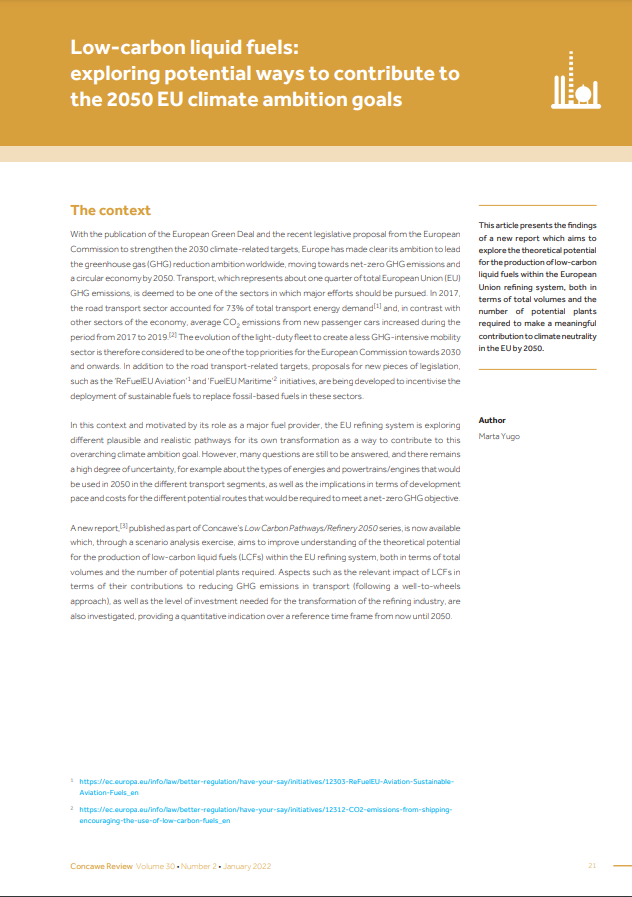
Concawe Reviews
Low-carbon liquid fuels: exploring potential ways to contribute to the 2050 EU climate ambition goals (Concawe Review 30.2)
With the publication of the European Green Deal and the recent legislative proposal from the European Commission to strengthen the 2030 climate-related targets, Europe has made clear its ambition to l...
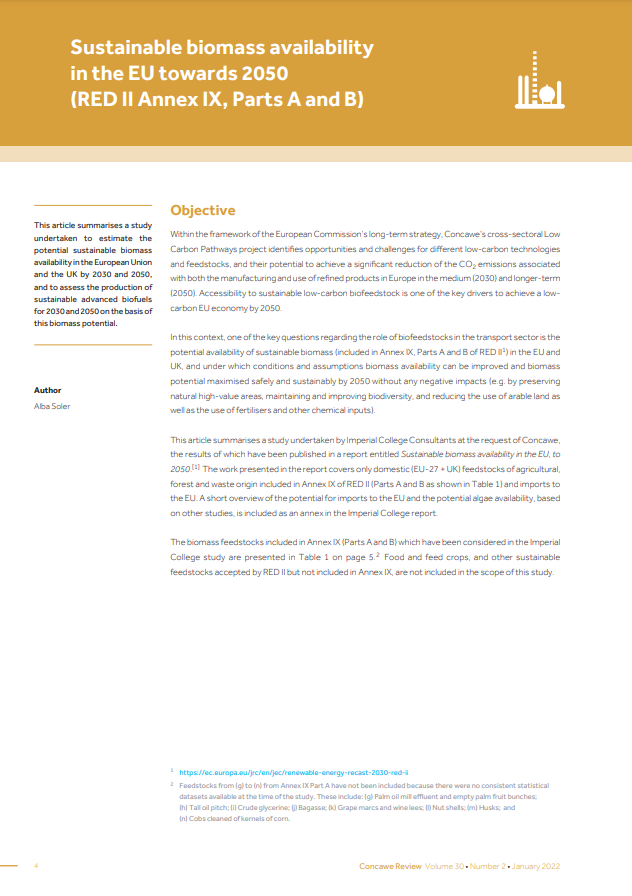
Concawe Reviews
Sustainable biomass availability in the EU towards 2050 (RED II Annex IX, Parts A and B) (Concawe Review 30.2)
Within the framework of the European Commission’s long-term strategy, Concawe’s cross-sectoral Low Carbon Pathways project identifies opportunities and challenges for different low-carbon technolo...
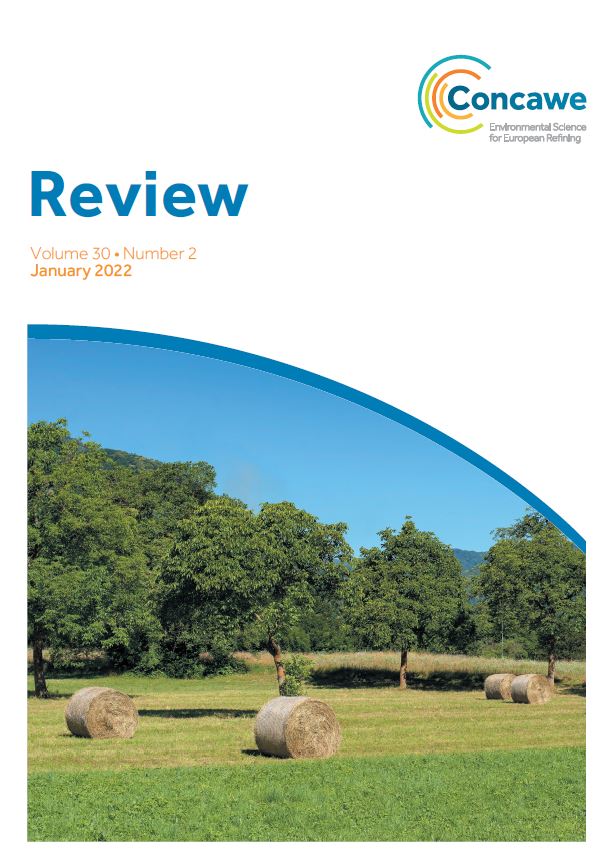
Concawe Reviews
Concawe Review 30.2
This Review adds some important articles to Concawe’s Low Carbon Pathways project, a programme started several years ago to develop a holistic view of how the refining industry could contribute to...

Concawe Reviews
Concawe’s response to the publication and presentation of T&E’s report “Magic green fuels: Why synthetic fuels in cars will not solve Europe’s pollution problems?”
T&E published a report on Monday 6 December, presenting their interpretation of the results of the lab tests they commissioned to IFPEN to measure air pollutant emissions of e-petrol in cars. Conc...
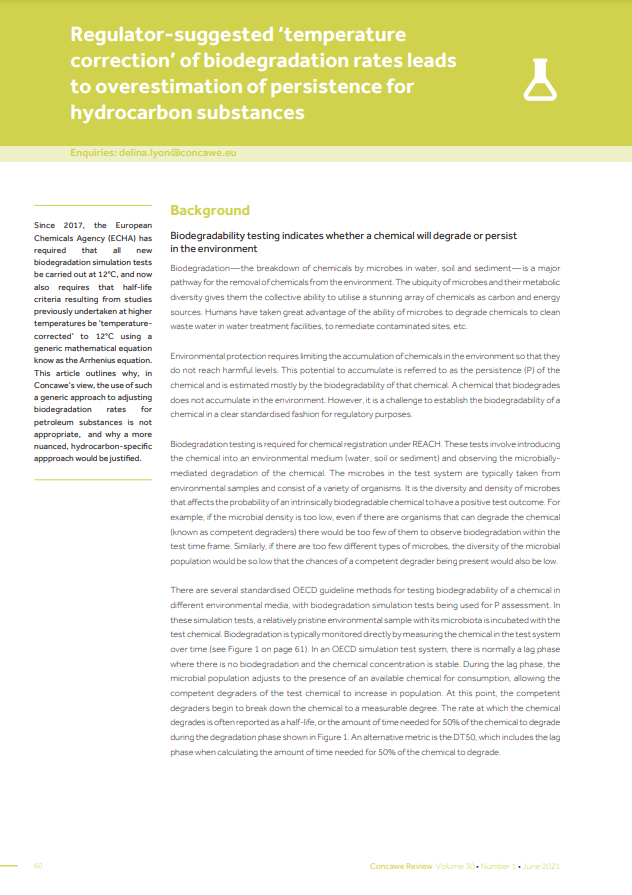
Concawe Reviews
Regulator-suggested ‘temperature correction’ of biodegradation rates leads to overestimation of persistence for hydrocarbon substances (Concawe Review 30.1)
Since 2017, the European Chemicals Agency (ECHA) has required that all new biodegradation simulation tests be carried out at 12°C, and now also requires that half-life criteria resulting from studies...
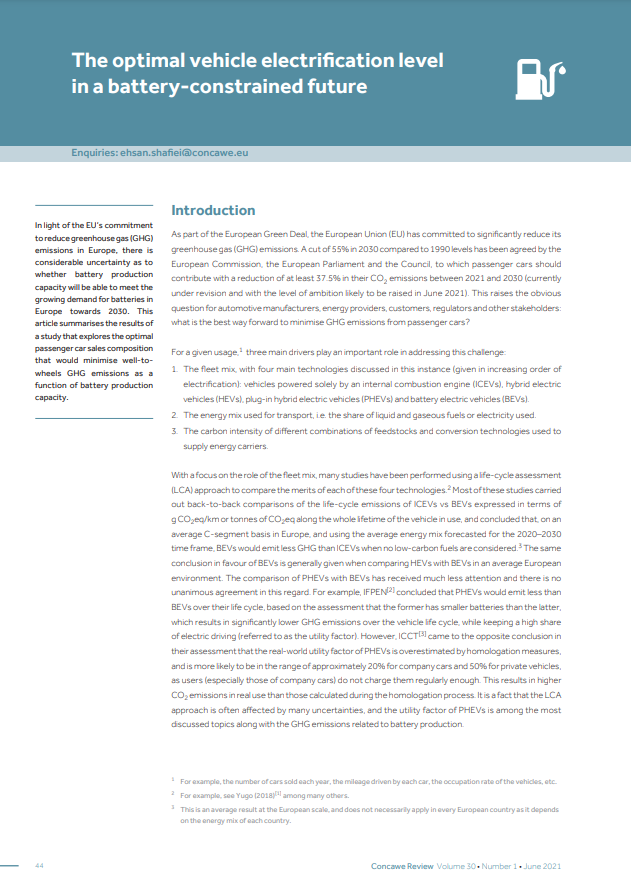
Concawe Reviews
The optimal vehicle electrification level in a battery-constrained future (Concawe Review 30.1)
In light of the EU’s commitment to reduce greenhouse gas (GHG) emissions in Europe, there is considerable uncertainty as to whether battery production capacity will be able to meet the growing deman...
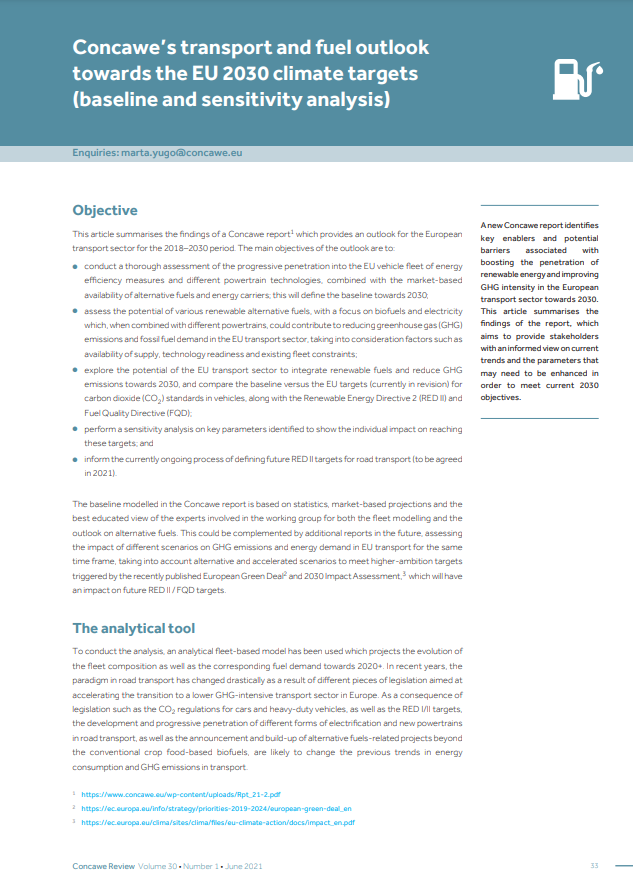
Concawe Reviews
Concawe’s transport and fuel outlook towards the EU 2030 climate targets (baseline and sensitivity analysis) (Concawe Review 30.1)
A new Concawe report identifies key enablers and potential barriers associated with boosting the penetration of renewable energy and improving GHG intensity in the European transport sector towards 20...
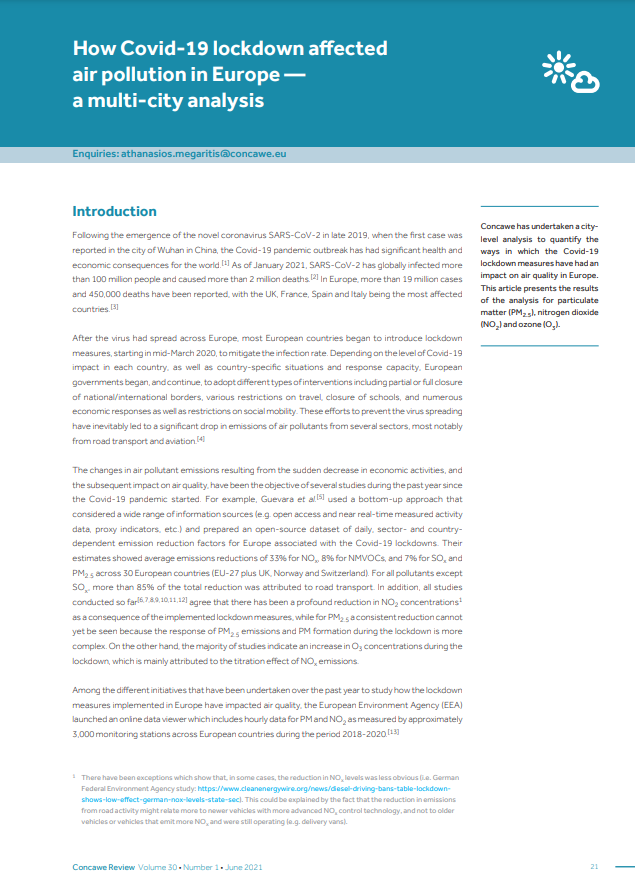
Concawe Reviews
How Covid-19 lockdown affected air pollution in Europe — a multi-city analysis (Concawe Review 30.1)
Concawe has undertaken a city-level analysis to quantify the ways in which the Covid-19 lockdown measures have had an impact on air quality in Europe. This article presents the results of the analysis...
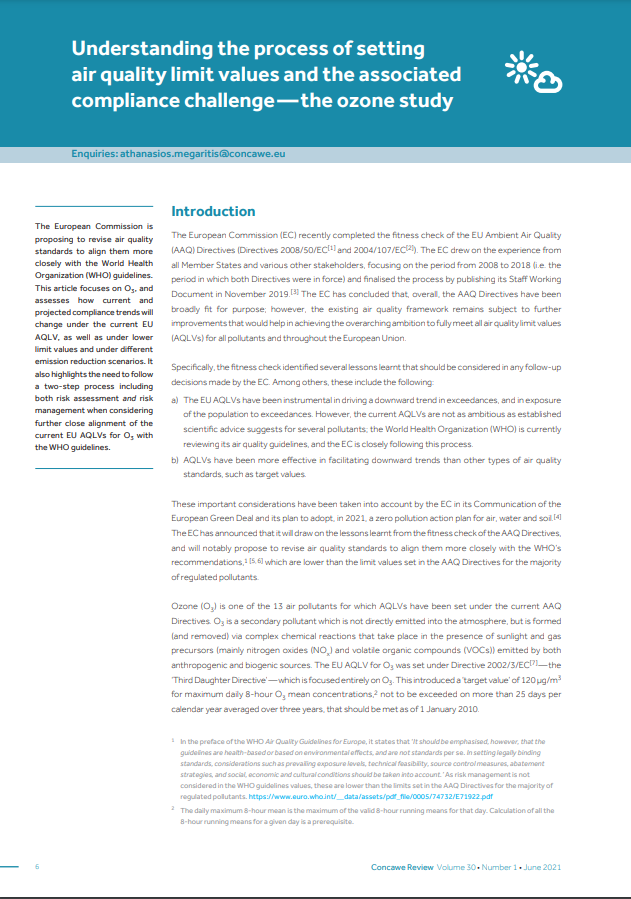
Concawe Reviews
Understanding the process of setting air quality limit values and the associated compliance challenge—the ozone study (Concawe Review 30.1)
The European Commission is proposing to revise air quality standards to align them more closely with the World Health Organization (WHO) guidelines.
This article focuses on O₃, and assesses how...
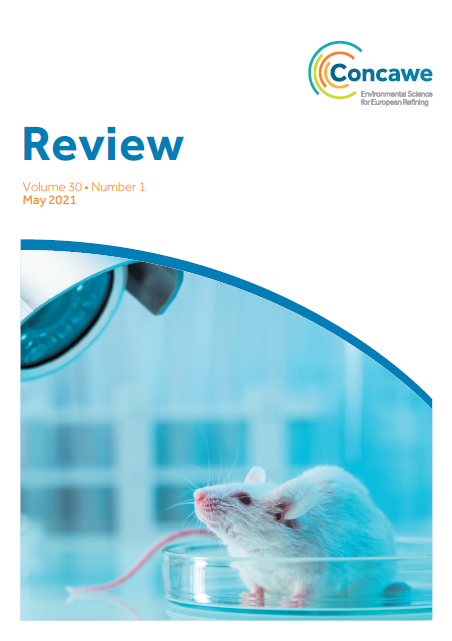
Concawe Reviews
Concawe Review 30.1
The European Green Deal tackles all aspects of our industry, and it is no surprise that all of the articles in this edition of the Concawe Review are related to it.
In light of the zero pollution act...
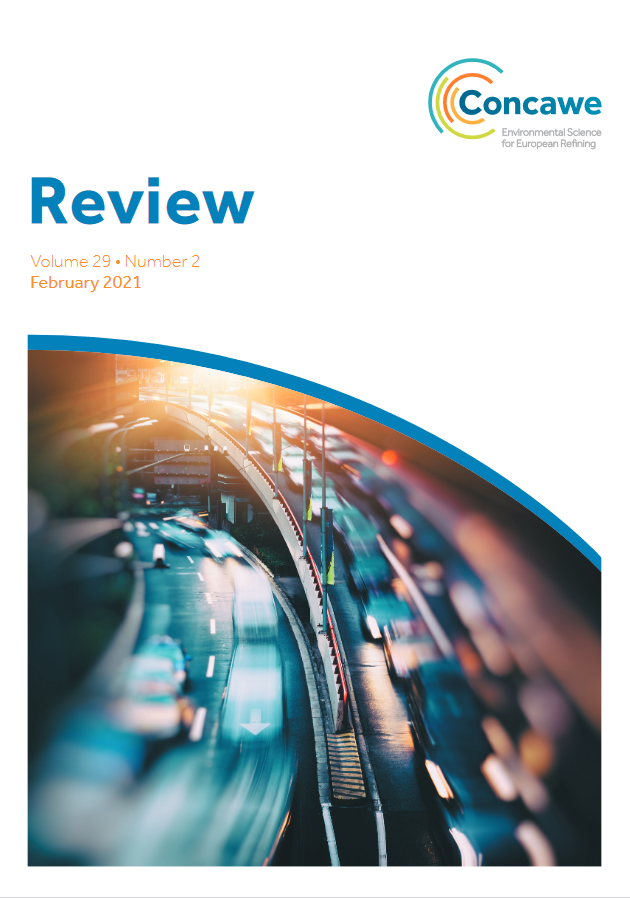
Concawe Reviews
Concawe Review 29.2
The move towards climate neutrality is clearly on its way: last year, the European Commission launched its Green Deal; and Japan, the Republic of Korea and more than 100 other countries worldwide have...

Concawe Reviews
Technology scouting—carbon capture: from today’s to novel technologies (Concawe Review 29.2)
Concawe has commissioned a new study to evaluate state-of-the-art carbon capture and storage (CCS) technologies, with a focus on commercial/near-term opportunities for CCS that are already in the mark...
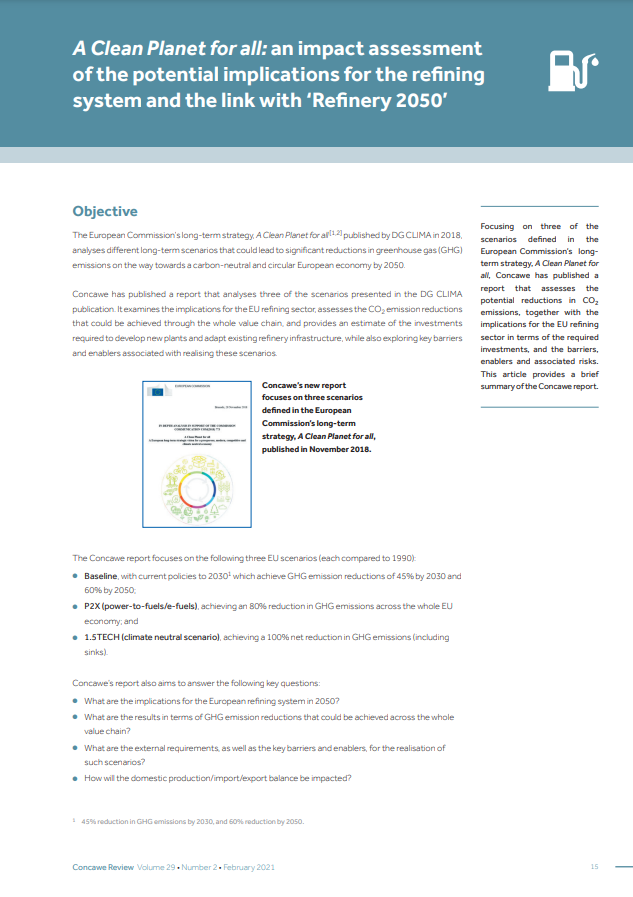
Concawe Reviews
A Clean Planet for all: an impact assessment of the potential implications for the refining system and the link with ‘Refinery 2050’ (Concawe Review 29.2)
Focusing on three of the scenarios defined in the European Commission’s long-term strategy, A Clean Planet for all, Concawe has published a report that assesses the potential reductions in CO2 emiss...
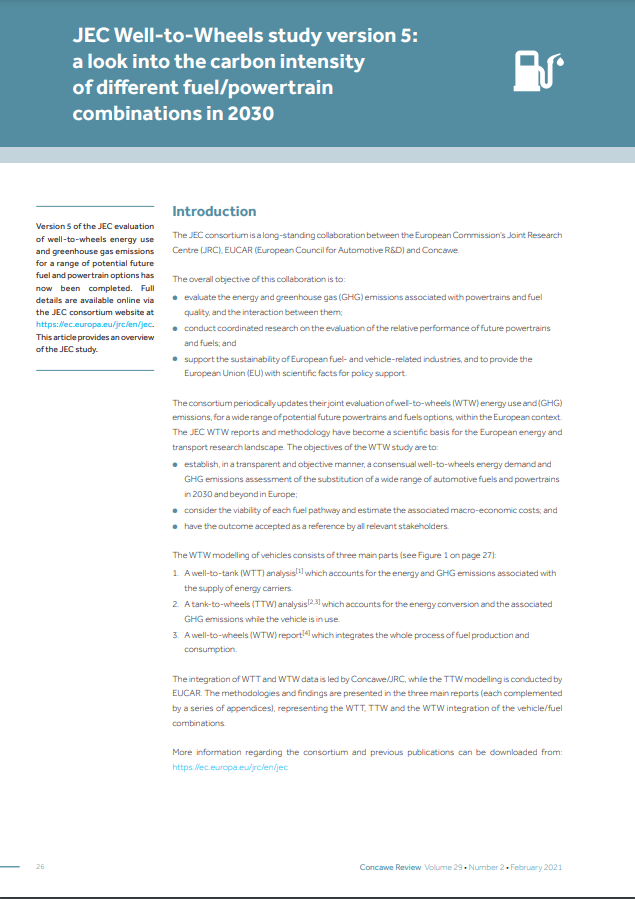
Concawe Reviews
JEC Well-to-Wheels study version 5: a look into the carbon intensity of different fuel/powertrain combinations in 2030 (Concawe Review 29.2)
Version 5 of the JEC evaluation of well-to-wheels energy use and greenhouse gas emissions for a range of potential future fuel and powertrain options has now been completed.
Full details are avail...
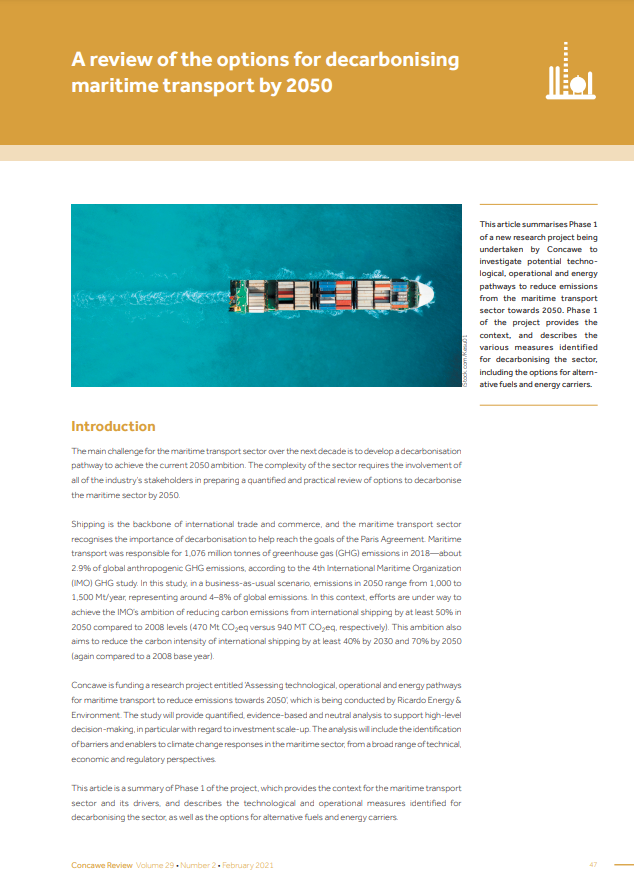
Concawe Reviews
A review of the options for decarbonising maritime transport by 2050 (Concawe Review 29.2)
This article summarises Phase 1 of a new research project being undertaken by Concawe to investigate potential technological, operational and energy pathways to reduce emissions from the maritime tran...
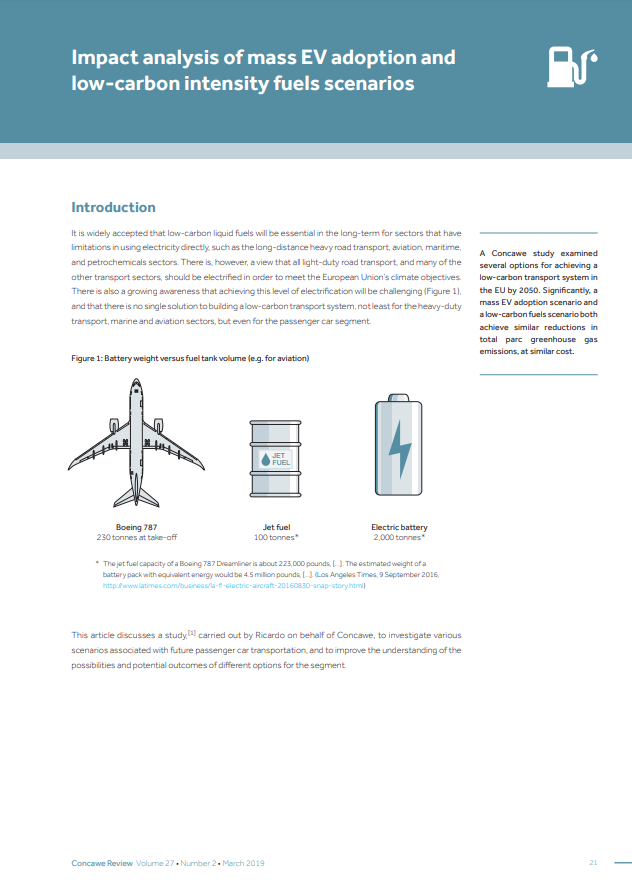
Concawe Reviews
Impact analysis of mass EV adoption and low-carbon intensity fuels scenarios (Concawe Review 27.2)
A Concawe study examined several options for achieving a low-carbon transport system in the EU by 2050. Significantly, a mass EV adoption scenario and a low-carbon fuels scenario both achieve similar...